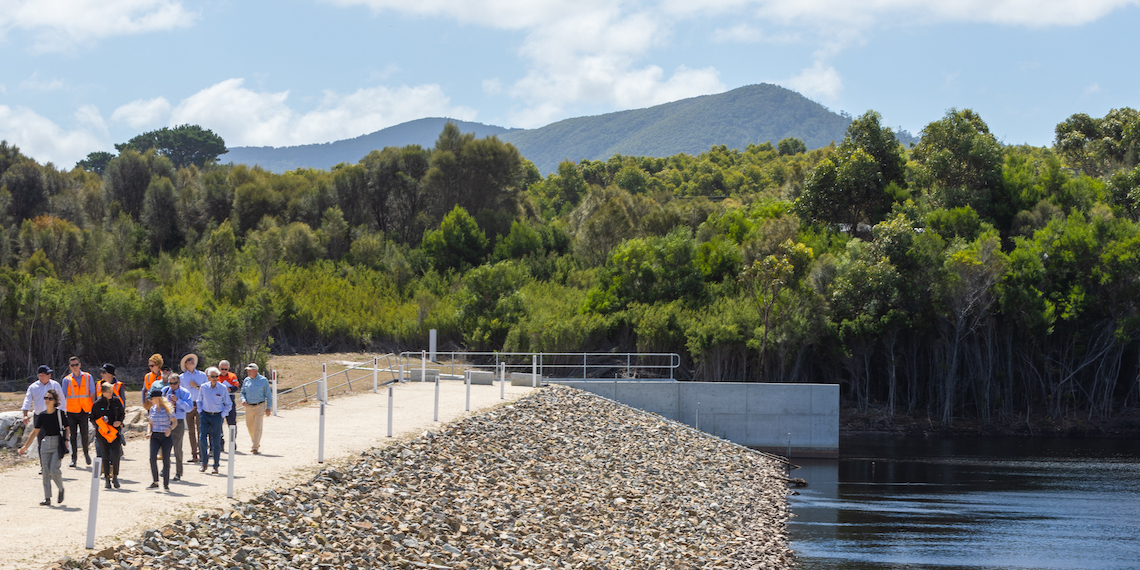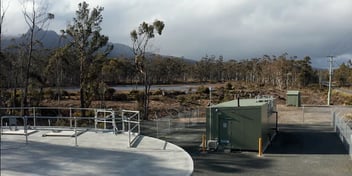Overcoming complications to deliver water security for Flinders Island

The Henderson Dam at Whitemark, Tasmania, has formally opened, with the new asset set to provide the remote Flinders Island community with drinking water security for generations to come.
Completed in 2022, the major infrastructure project’s delivery came with significant challenges. Aside from disruptions caused by the COVID-19 pandemic, the project also ended up being much larger than expected due to the condition of the dam.
TasWater General Manager Project Delivery Tony Willmott said the focus on Flinders Island’s water security was part of the utility’s broader efforts to dramatically improve water service provision across Tasmania via its $1.1 billion capital works program.
“When TasWater was established in 2013, we took over all of the water and sewage assets for all of the councils around the state – and the Flinders Council was one of them,” he said.
“The business went on a very early campaign of understanding its risks, and drinking water quality was one of our highest risks from a customer perspective. Our 24glasses Regional Towns Water Supply Program was established to mitigate this issue.”
Flinders Island was a site that had fairly basic treatment before TasWater was established, Willmott said, but the community had also been struggling with drought.
“We put a membrane treatment plant in first, but then the island started to suffer from very poor rainfall, which caused that dam to be way too small to get the community through the summer,” he said.
“There was a risk of losing water supply to the main part of the island, so we embarked on a project to fix the dam.”
Willmott said the original dam was very basic and, despite having served its purpose, the team wasn’t sure what the dam would look like inside.
“As part of the project development, we worked with the construction team associated with our Capital Delivery Office Alliance to investigate,” he said.
Curve balls
The plan was to raise the height of the dam to more than double its storage volume, from 40 megalitres to 92 megalitres. Willmott said that, while Henderson Dam is relatively small, the project posed some big challenges,
“When they excavated the notch, to make sure it was safe to build a new spillway, the cross section of the dam showed that the dam was in very poor condition,” he said.
“When we stripped the core back, we found problems. There was significant risk of piping due to tree-root inundation. And the way the dam was keyed into the foundation below also posed risks.
“Our dam engineer indicated that the condition of the dam could not be certified to modern standards. The dam was not good enough to be left as it was. We could no longer just retrofit.”
Willmott said that, after inspecting the dam, it became clear that TasWater didn’t have a choice other than to rebuild the asset correctly.
“When they identified the poor structural issues the project team reported their findings back to our Asset Management Services team for further consideration.
“A hard decision was made, which was to totally remove the dam and start again from scratch.”
Further to the significant increase in the project's deliverables, Willmott said construction was also impacted by the COVID-19 pandemic.
“It’s tricky enough trying to complete a major infrastructure project on an island, but construction occurred during COVID, as well. At one stage, we had to stop our contractors from going to the island all together,” he said.
“This was to ensure that the island’s population wasn’t placed at increased risk of infection – and the last thing we wanted to do was bring the coronavirus into the community.
“So the decision was made to demobilise the project team until COVID was over.”
Opportunity in challenge
Despite these challenges, the Flinders Island community is now serviced by a brand new dam that meets modern standards and can hold more than double the amount of water than the original structure.
“The dam was a bit shorter originally. During reconstruction, we took the opportunity to change the angle of the dam and key it into the rock foundation much more effectively. So, the dam is slightly longer now, with a slight offset along the alignment,” Willmott said.
“And it’s built to last. It’s a 100-year asset and will work well for decades to come. It can now store around 90-100 megalitres. It’s not massive, compared to other dams, but it’s for an island that only had 40 megalitres before, so it’s a great improvement when it comes to water security.
“It’s going to enable the community to get through longer dry spells.”
To maintain the water supply while the dam was empty during construction, a temporary reverse osmosis water treatment plant was installed at Lady Barron, an above-ground temporary raw water storage dam was constructed alongside South Pats River, and a schedule of water carting between the two facilities was put in place.
“We were really appreciative of the community’s understanding while we were solving the challenges we identified while delivering the project.
“The council, along with our communication’s team, did an excellent job in engaging the community and keeping them well informed. They did a great job of assuring the community that we were working on a longer-term solution.
“This is what TasWater was set up for, to make sure we can get better water out to our regional and remote areas, and provide a safe and reliable supply.”
The project represents a $17 million investment by TasWater, and forms part of the TasWater $1.1 billion capital works program across the next four years in all regions of Tasmania.
“The project was also successful because of the work delivered by our partners UGL Limited and CPB Contractors, who along with TasWater form the Capital Delivery Office have done a fantastic job dealing with the unforeseen issues thrown at us in the middle of the project,” he said.
“The construction team has been excellent, they adapted quickly and came up with a great solution.”

